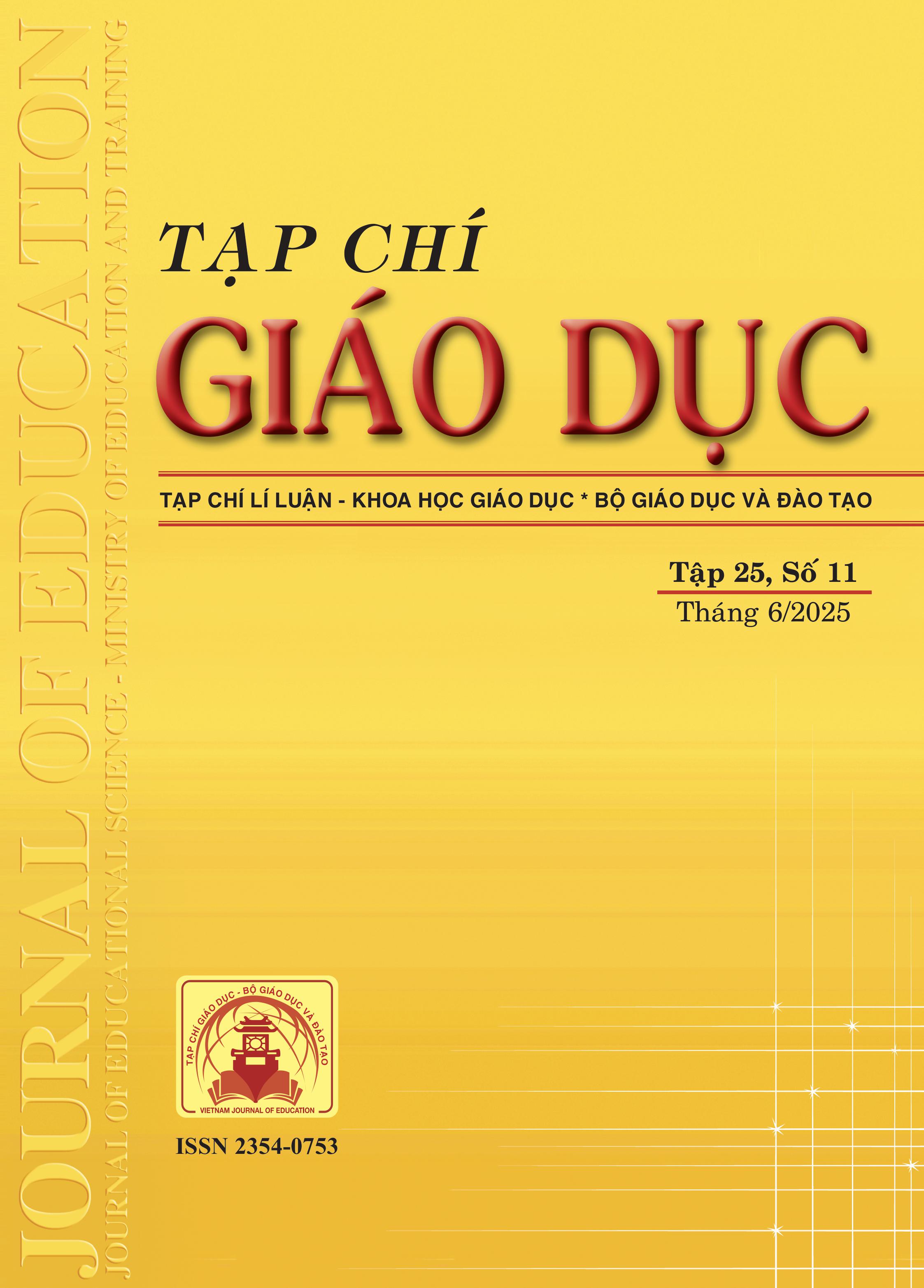Sử dụng phương pháp kỉ luật tích cực trong can thiệp hành vi gây hấn ở học sinh tiểu học
Tóm tắt
Aggressive behavior in elementary school students is a significant concern in education as it can lead to negative consequences such as school violence if not identified and addressed promptly. In reality, many teachers and parents still handle this behavior through punishment, especially corporal punishment, which negatively impacts children's psychology. This article focuses on analyzing the theoretical basis of aggressive behavior and introduces positive discipline methods as an appropriate approach for teachers to effectively intervene in these behaviors. By reviewing the theory, this article contributes to providing a scientific basis and practical guidance for teachers and parents in recognizing and responding to aggressive behavior in elementary school students in a positive and humane manner.
Tài liệu tham khảo
Allen, J. J., & Anderson, C. A. (2017). Aggression and violence: Definitions and distinctions. The Wiley Handbook Of Violence and Aggression, 1, 1-14.
Anderson, C. A., & Bushman, B. J. (2001). Effects of violent video games on aggressive behavior, aggressive cognition, aggressive affect, physiological arousal, and prosocial behavior: A meta-analytic review of the scientific literature. Psychological Science, 12(5), 353-359. https://doi.org/10.1111/1467-9280.00366
Berkowitz, L. (1993). Aggression: Its causes, consequences, and control. New York, NY: Academic Press.
Bộ GD-ĐT (2020). Thông tư số 28/2020/TT-BGDĐT ngày 04/9/2020 ban hành Điều lệ trường tiểu học.
Bùi Quang Huy (2021). Bạo lực học đường: Gia đình, nhà trường, xã hội cùng giải quyết. https://tienphong.vn/bao-luc-hoc-duong-gia-dinh-nha-truong-xa-hoi-cung-giai-quyet-post1326228.tpo
Charles, C. M., & Senter, G. W. (2005). Building classroom discipline: Overview of Nelsen, Lott and Glenn’s model. Pearson New International Edition.
Durrant, J. E. (2016). Positive Discipline in everyday Life. Save the children.
Heilmann, A., Mehay, A., Watt, R. G., Kelly, Y., Durrant, J. E., van Turnhout, J., & Gershoff, E. T. (2021). Physical punishment and child outcomes: a narrative review of prospective studies. The Lancet, 398(10297), 355-364. https://doi/10.1016/S0140-6736(21)00582-1
Kellam, S. G., Ling, X., Merisca, R., Brown, C. H., & Ialongo, N. (1998). The effect of the level of aggression in the first grade classroom on the course and malleability of aggressive behavior into middle school. Development and Psychopathology, 10(2), 165-185.
Lê Văn Hảo (2009). Phương pháp kỉ luật tích cực. Tổ chức Plan tại Việt Nam.
Mabuza, N., Makondo, D., & Bhebhe, S. (2017). Perceptions of primary school teachers on positive discipline in the Manzini Region of Swaziland. Asian Academic Research Journal of Social Science and Humanities, 4(9), 201-219.
Morin, A. (2018). The difference between discipline and punishment. https://www.understood.org/articles/en/the-difference-between-discipline-and-punishment
Naker, D. & Sikitoleko, D. (2009), An Introductory Handbook For Promoting Positive Discipline In Schools For Quality Education: Alternatives to corporal punishment. Raising voices, Kampala: United Nations Children’s Fund.
Nelsen, J., & Lott, L. (2010). Positive Discipline for Teenagers, Revised 2nd Edition: Empowering Your Teens and Yourself Through Kind and Firm Parenting. Harmony.
Nguyễn Thị Bích Thủy (2019). Hành vi gây hấn của trẻ vị thành niên có hoàn cảnh đặc biệt trên địa bàn Thành phố Hồ Chí Minh. Tạp chí Tâm lí học xã hội, 3, 89-96.
Nguyễn Thị Tính, Nguyễn Thị Thanh Huyền, Trần Thị Minh Huế, Lê Công Thành (2013). Giáo trình giáo dục học. NXB Giáo dục Việt Nam.
Parfilova, G. G. (2016). Managing and preventing aggressiveness in primary school children. International Electronic Journal of Mathematics Education, 11(4), 921-931.
Patterson, G. R., Forgatch, M. S., Yoerger, K. L., & Stoolmiller, M. (1998). Variables that initiate and maintain an early-onset trajectory for juvenile offending. Development and Psychopathology, 10(3), 531-547.
Pettitt, B., Greenhead, S., Khalifeh, H., Drennan, V., Hart, T., Hogg, J., ... & Moran, P. (2013). At risk, yet dismissed: The criminal victimisation of people with mental health problems. https://eprints.kingston.ac.uk/id/eprint/28922/
Trần Thị Mỵ Lương, Trần Hằng Ly (2020). Gây hấn học đường ở học sinh trung học cơ sở - nghiên cứu tại tỉnh Nghệ An. Tạp chí Giáo dục, 478, 60-64. Waheeda (2019). What is positive discipline? And the best 15 discipline techniques that work. https://messyyetlovely.com/what-positive-discipline-techniques/
Wei, L. F., Chang, S. H., & Lin, C. Y. (2018). A Study on the Effect of Students’ Perception of Teachers’ Positive Discipline on Bullying Prevention in Primary Schools in the Taiwan Region. International Journal of Information and Education Technology, 8(5). 369-375.
Tải xuống
Đã Xuất bản
Cách trích dẫn
Số
Chuyên mục
Giấy phép

Tác phẩm này được cấp phép theo Ghi nhận tác giả của Creative Commons Giấy phép quốc tế 4.0 .












